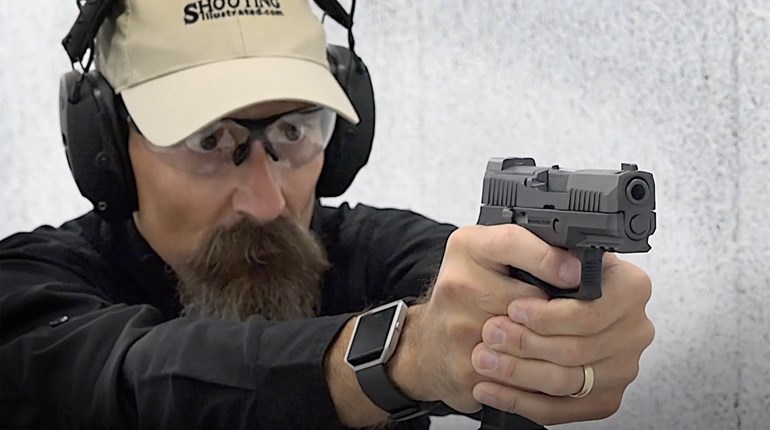
Given either a combative or competitive shooting scenario, there is a high likelihood that the shooter will be placed under a performance demand requiring the completion of more than one task.
In defensive applications there may be more than one threat presented demanding a viable shooting solution. At a competition there could be a multi-target array set up at varying degrees of technical difficulty. Either scenario requires the shooter to perform multiple tasks and at the best of their ability.
What does it take to successfully accomplish more than one sequential task while being held accountable for accuracy, speed and penalty of failure?
Among the topmost recommended guidelines are to follow a single-step shooting process, remain cognizant of the ubiquitous Psychological Refractory Period and default to your ‘guaranteed hit’ skill level as opposed to reach beyond it.
Single Step Process
The shooting requirement, and overall objective, may be to draw your handgun from concealment, place two rounds on target one (T1) followed by two rounds on target two (T2) for a total of four rounds distributed over two targets. The best-kept secret to mission success is to complete each task one step at a time.
The first step to completing an overall objective (two rounds on two targets), is to clearly identify each of the tasks. You can’t address something in detail that you cannot identify.
Although only two targets with a total of four rounds, there are eight separate tasks:
1. Perform a rapid presentation from concealment
2. Place one round on T1
3. Control recoil muzzle movement reacquire acceptable alignment on T1
4. Place another round on T1 in a timely manner
5. Transition from T1 to T2
6. Place a single round on T2
7. Control recoil muzzle movement and reacquire alignment on T2
8. Place an additional round on T2 in a timely manner.
Broken down into single-step processes, there are a total of eight individual tasks.
Each task is measurable holding it to either a set standard or minimally to the accountability of an overall time or predetermined accuracy requirement.
Complete one task at a time, do it well, then physically and mentally detach from that current task, as it is now completed, and move immediately on to the next one.
The body cannot go where the mind has not been. It’s important to remain mentally engaged with each task sequentially. The magic is to complete one item at a time and in sequence. Don’t split your thinking into multiple tasks. If you do, mentally, it will be like putting one foot in two separate canoes while trying to navigate a flowing river. Instead, get one thing done at a time, get it done well, and then move on to the next one.
Yes, of course, there is a peripherally cognitive awareness of the second, third and subsequent tasks. However, your full and laser-beam-like mental focus must be placed on one task at a time.
Psychological Refractory Period
Upper-level competitors and defensive shooters alike are well aware of the Psychological Refractory Period – also known as PRP – and its impact on the time component of task completion.
PRP is that period following response to an initial stimulus during which response to a second stimulus, presented shortly after the first, is delayed. In other words, if you perform two tasks sequentially, then the first task takes longer than if there wasn’t a second one.
Single tasks performed in isolation, with no subsequent tasks, are done so at optimal speeds unencumbered by PRP. It’s when you add more tasks to your list that it takes effect. The greater the number of tasks, the longer the delay for each of the earlier tasks.
PRP isn’t a ‘bad’ thing per se, it’s just how we humans operate. The takeaway here is to not set your expectations too high for a multitask as you would for a single task. Know that your time is a measure impacted by an increased number of subsequent tasks.
The answer to this conundrum is perfect practice. The more correct reps you have into a task the greater your familiarity. The greater your familiarity the greater your comfort, which in turn raises your confidence and in turn makes you a more competent shooter.
Default versus Reach
When tasked with performance some shooters step up to that firing line, roll up their sleeves and “try” to push their accuracy-time factor beyond what they can ‘guarantee.’
The more effective method of managing any task is to perform well within your capability margins. If you can come screaming out of your holster and nail a .95-second head shot five times out of five from the five-yard line then that’s your default time for that task. We can all catch lightning in a bottle every now and again, but if it’s not your default then you’re reaching.
Reaching beyond your skill level even on a single task is non-repeatable and therefore unreliable. It’s always the wiser choice to fall back to your default skill level where you have at least an 80 to 85 percent chance of performance repeatability.
Identifying and performing one task at a time, being cognizant of PRP, setting realistic expectations and relying on the success of your default performance, all conspire to make you a better shooter.




































